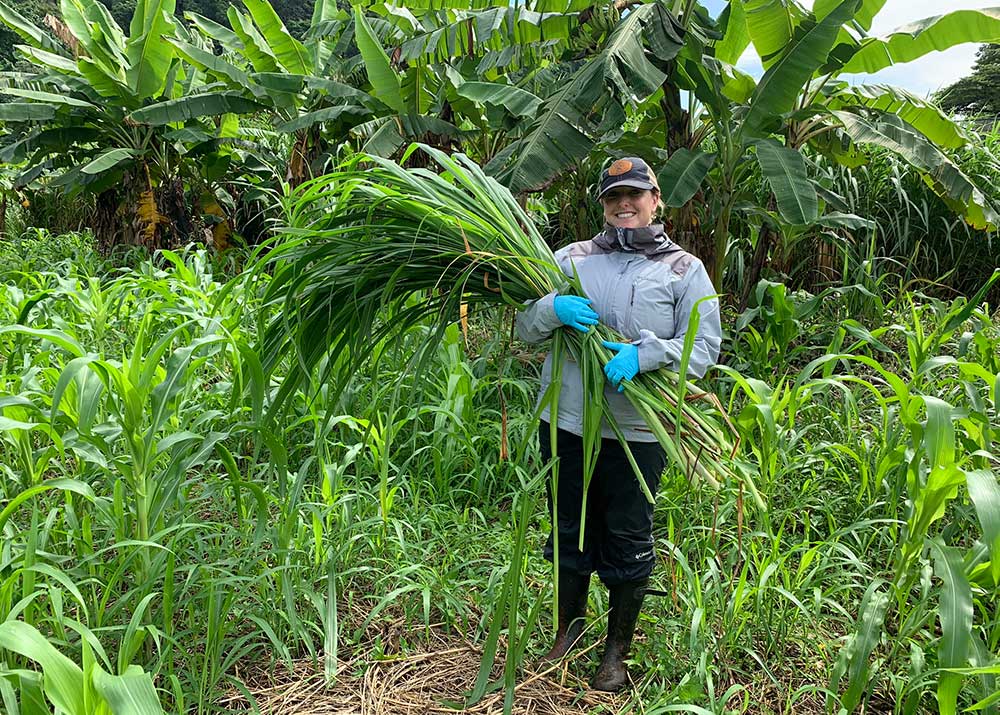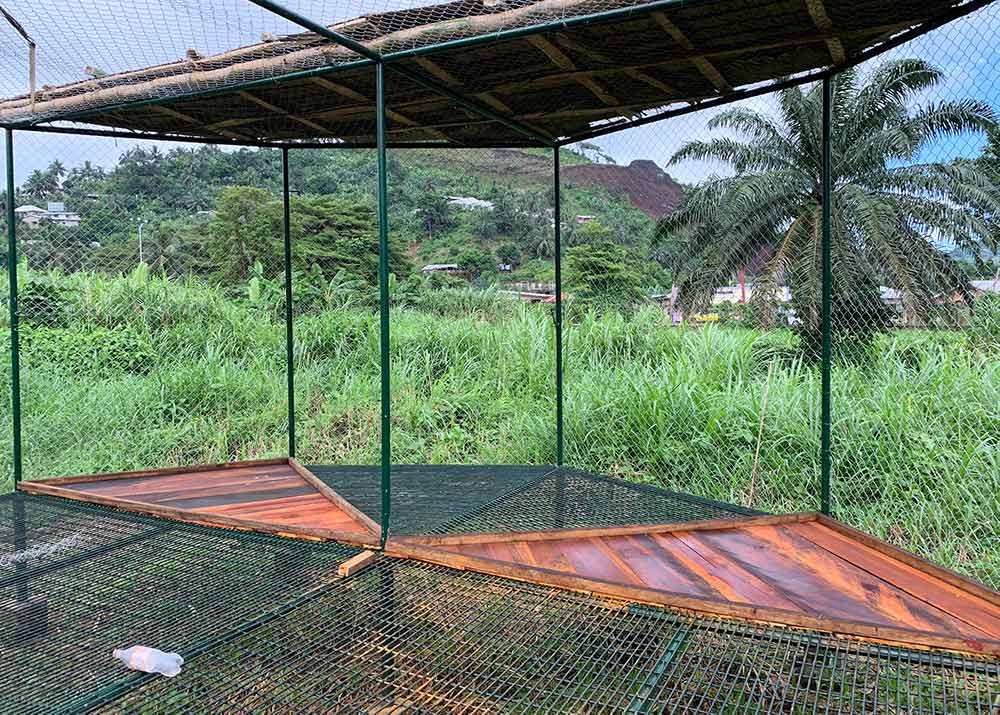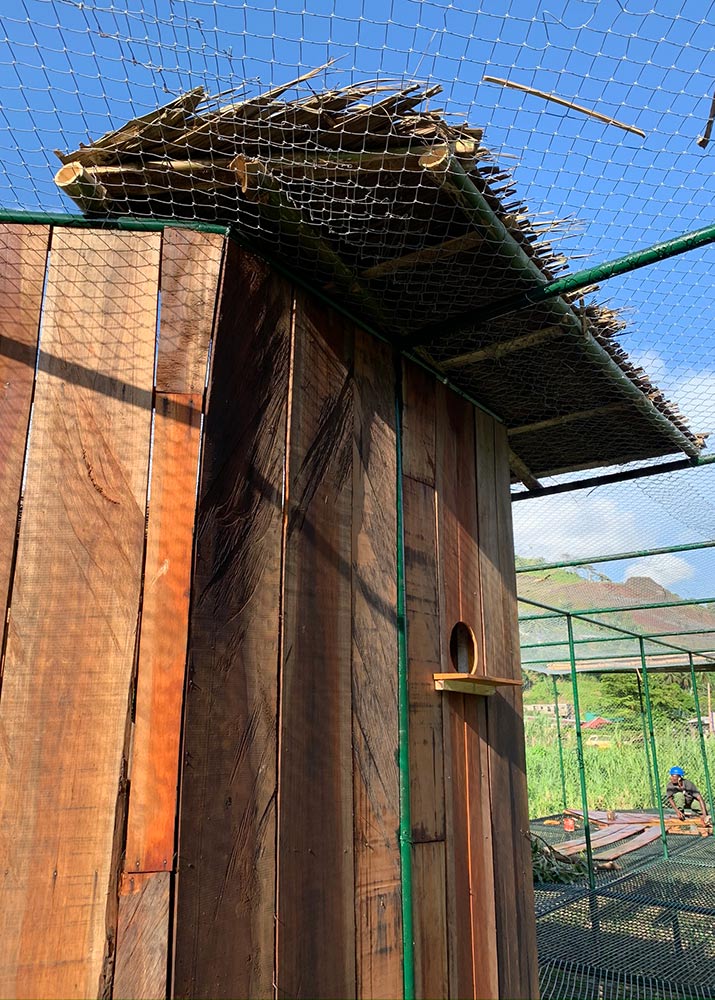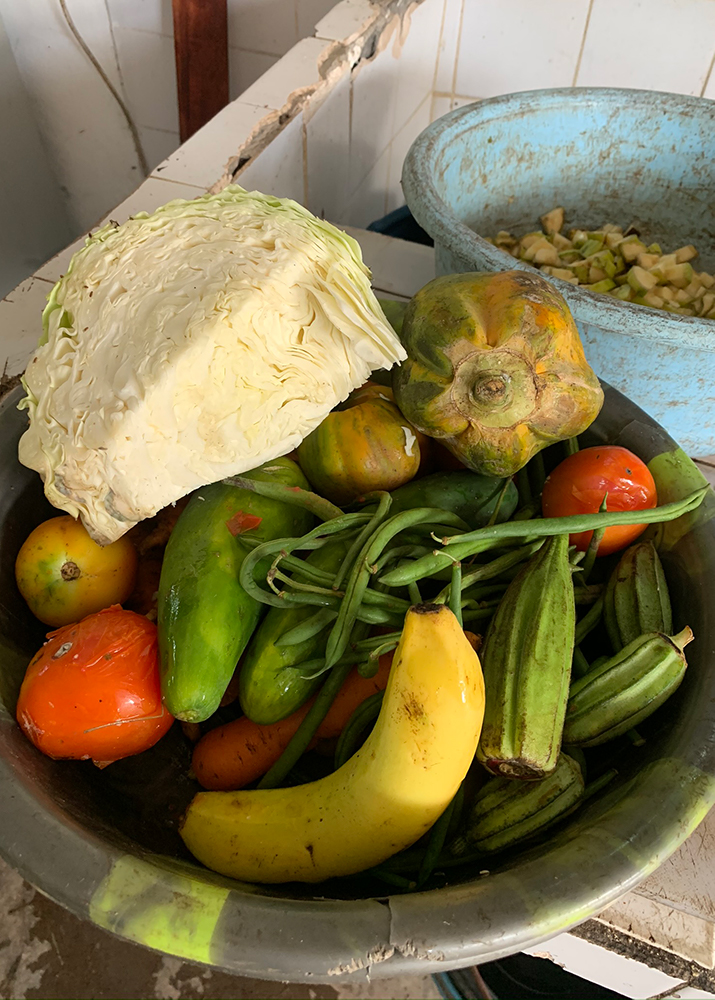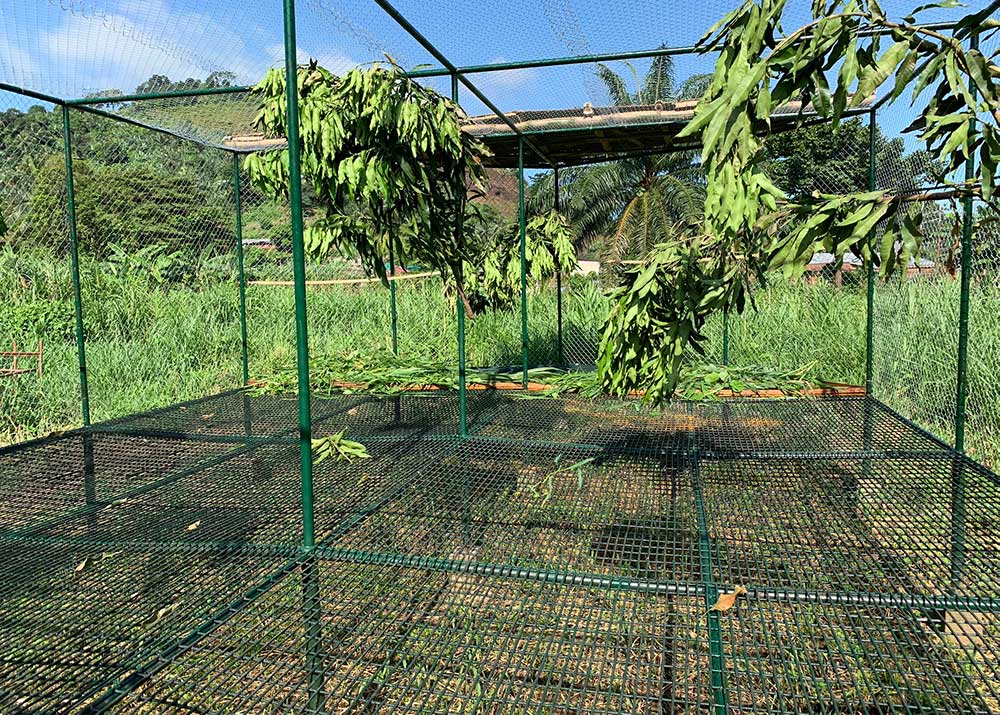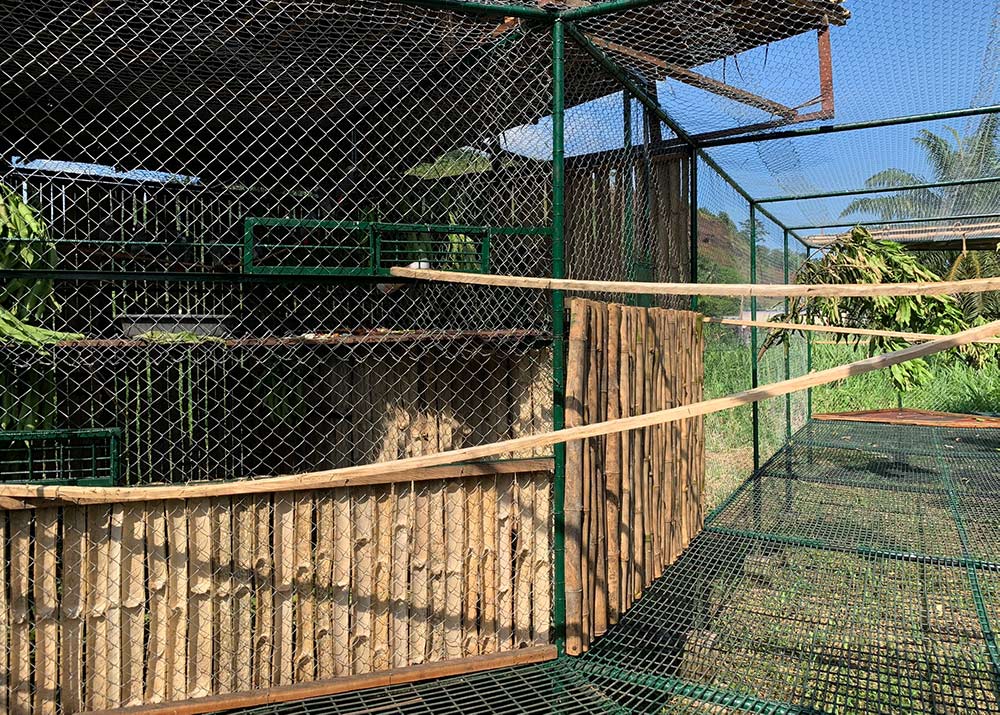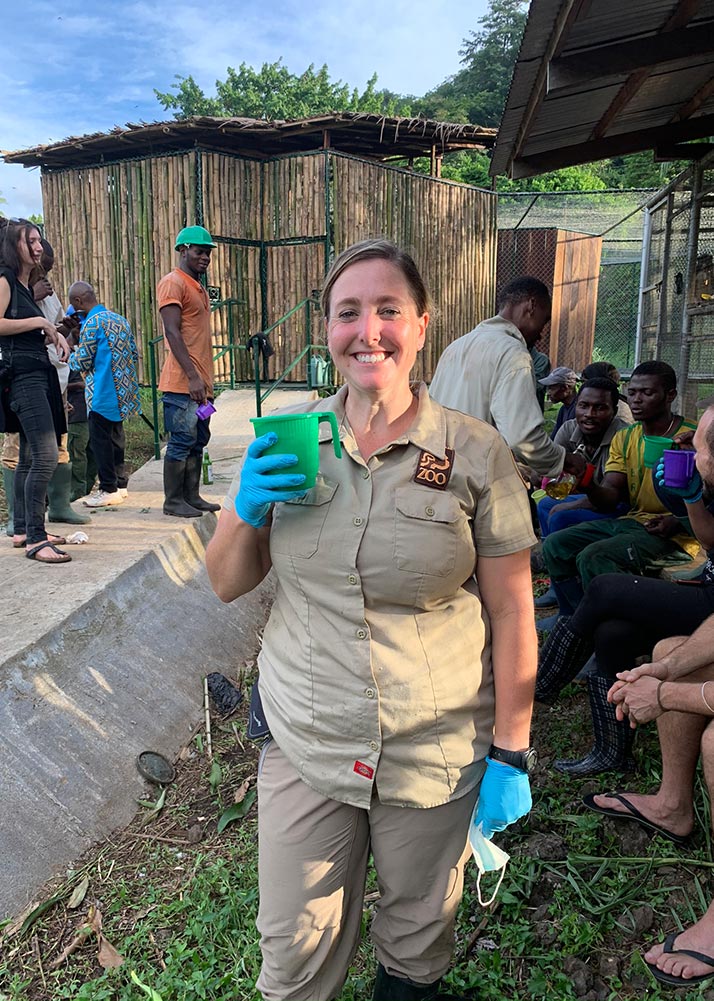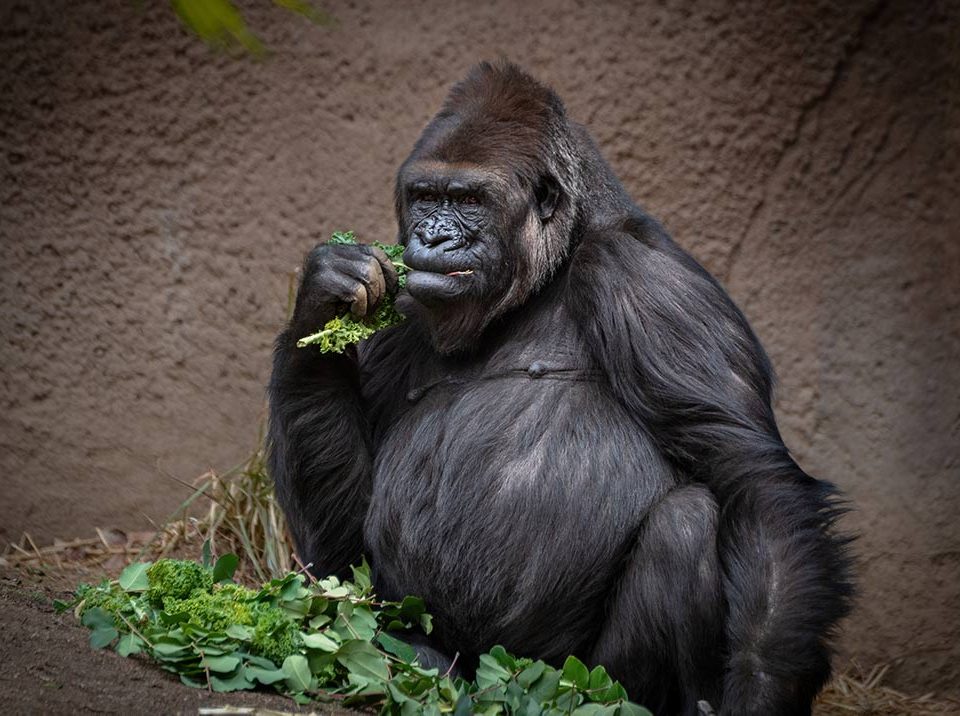From the Field: African Gray Parrot Rehabilitation

New in the Zoo
January 7, 2020
Zoo Update with Tom Jacobson
January 7, 2020
Marshall wields a machete, the preferred browse cutting tool during her stay at the Limbe Wildlife Centre. Photo courtesy of Kristen Marshall
Animal Keeper Kristen Marshall had always been interested in applying for the Ornato Advanced Field Studies grant and representing the Los Angeles Zoo while pursing fieldwork. In fact, learning about the many conservation programs that the L.A. Zoo supports was one of the reasons she became interested in working at the Zoo. Marshall has been on staff since 2013 and was overjoyed when she received a 2019 Ornato grant that enabled her to work with the Limbe Wildlife Centre (LWC) in Limbe, Cameroon. She spent two weeks in October 2019 at the LWC, but her work there began months earlier in April 2019, when she started researching fieldwork opportunities. As part of the Zoo's bird staff, she was excited to learn that LWC was in the process of establishing a conservation project for African gray parrots, a species classified as Endangered by the International Union for the Conservation of Nature (IUCN) due to escalating habitat loss and over-collection for the pet trade. Although she had not worked with African grays specifically, she had extensive parrot experience that she knew would serve the LWC well. Marshall shared the story of her two-week sojourn in Cameroon.
My Journey to Cameroon
The Limbe Wildlife Centre (LWC) is the only facility in Cameroon that provides rescue, rehabilitation, and release programs for African gray parrots. The main goal is to return parrots confiscated from wildlife traffickers or otherwise in need of rehabilitation to their natural habitat as quickly as possible. When I began communicating with LWC, they were in the early stages of planning a large rehabilitation aviary to better accommodate the parrots in their care and I was able to view the original plans for this aviary. In July 2019, construction of the new housing that is so crucial to the success of this program began.
My journey to Limbe, Cameroon started on October 21. It was long and tiring, but I arrived at the volunteer house on the evening of October 22. Since I would be in Limbe for two short weeks, I immediately started my work at the center the following morning.
The LWC requires all visiting volunteers to go through a quarantine process upon arrival. This ensures that all people and animals at the center remain healthy and safe during their time there. As a result, I was not able to have contact with the animals during my first two shifts-but there was still plenty of work and learning to be done. I spent these two days touring the center, getting to know the layout of the facility, and meeting the wonderful, passionate staff and volunteers. I also met with management and discussed exactly what my role there would be. The foundation of the new parrot rehabilitation aviary had been completed, but the LWC wanted my assistance in designing the finishing touches to make the space optimal for the birds.
During my medical quarantine, I could hear the African grays at the facility singing and chatting away; I couldn't wait to be out of quarantine, so I could get a good look at the birds that I would be assisting in the coming days.
October 25 was the first day I was allowed to work around the LWC animal collection and view the parrots that I had traveled so far to assist. Since they did not have other housing at this time, they remained in the quarantine section of the facility under the care of the head quarantine keeper, Killi.
When I was first introduced to Killi, he seemed very serious and quiet, although I could see immediately his passion for working with the animals under his care. I shadowed him, assisted with the animals that were his charges, and learned how they care for the African gray parrots as well as the primate species kept in this section. I prepared diets, crafted enrichment items, and cleaned the animal exhibits. Due to the nature of the rehabilitation and release program for the African gray parrots, the LWC limits the contact that employees and volunteers have with these animals. Since the goal of the program is to release these birds into their natural habitat, the LWC does not want the parrots to get used to people. I felt very fortunate to be one of the few individuals allowed to work closely with the birds.
The following day was one that I will always remember. It was the day that Killi and I went to the new rehabilitation aviary and discussed how we wanted to set up the interior for the birds. I had had previous meetings about this with the management team and had toured the new caging during my time under quarantine, but this was the first time I was able to discuss the plans with the keeper.
The aviary was approximately 72 feet by 36 feet. It consisted of two smaller shift or management cages that would be used for feeding, medical examinations, and gradual introduction of new birds to the existing flock. These two management cages led into the main aviary, which is a large circular structure. Avoiding sharp angles allows the birds to fly continuously, providing them a large straight away to fly and perch. We decided to add more shelter space for the birds to protect them from the different weather conditions of Limbe. This meant adding extra roofing to the top of the caging. Killi had observed that the African grays liked to forage in browse or grass at the bottom of the quarantine cage, so we designed two triangular forage boxes that would be placed under the extended roofing to allow them to continue this behavior. We also discussed how the perching needed to be arranged, particularly for the initial introduction of the parrots to the new aviary.
The birds had been living in two small, metal cages that did not have much space for flight, so they would need to train and develop the muscles for long flights again. Perching would need to be abundant and placed close together to start with; then as the birds progressed some of the perching could be removed and placed further apart to increase flight distance. This would allow the birds to build up the necessary muscle mass imperative to a successful future release. We also talked about adding shelter/nest boxes to the middle of the main portion of the exhibit, although reproduction is not a main goal of the facility.
Designing the Parrot-Perfect Space
As we discussed ideas on how to design the living space for the birds and I shared the ways we design similar structures at the Zoo, I gained Killi's trust. His face lit up with excitement for the birds in the collection. His passion was palpable and contagious. It was clear that all he wanted was for these birds to have proper housing during their rehabilitation time at LWC. Killi, management, and I met with the construction staff who would be building all of the necessary items. This was a lot of work in a short time frame, since management wanted it to be completed while I was at the center. The construction staff got started immediately.
The next two days went by quickly. Sundays at the center are very quiet due to the limited number of staff there, but I continued working in the quarantine area with Killi and learned how they care for the parrots. I also observed training sessions with the four chimpanzees in this area. Training has been a passion of mine throughout my career and it is one of my favorite parts of my job, so I was thrilled to observe and discuss training sessions with the LWC keepers. When they learned of my training background and experience, we had in-depth conservations about training, and I shared advice on the sessions.
Back from the Ghost Town
October 28 was my one day off. Due to the civil crisis that is currently unfolding in Cameroon, Mondays are known as "ghost town." Businesses are closed, people do not go to work, and many children do not attend school. Limbe is more relaxed with "ghost town" days than many other areas in Cameroon, but volunteers are asked to stay home from the center because of the unrest and only necessary staff go to work.
Tuesday it was back to work for me and probably one of the busier days I had at the center. Killi and I started first thing preparing the holding/management cages that the 15 African gray parrots currently at the LWC would be moving to that afternoon. We collected perches and placed them, and then we assisted construction with moving essential items to the aviary so they could continue working on the inside of the caging. We reviewed and approved the first nest box that construction completed so that they could go on to finish the other two we requested. All 15 parrots were given physicals this day and I was able to assist with the process. Afterward, the birds were placed into a large crate and moved into the new management cages at the rehabilitation aviary. It was an exciting day for all the staff, since they had been working diligently for months on this project. The birds were now in appropriate caging and a celebration blessing was performed at the end of the work day shift to celebrate the opening of the new exhibit. This tradition occurs at the opening of each new animal exhibit/housing area at the center.
The following day Killi was off, so I served as the main keeper caring for the parrots in the new aviary. I spent a lot of time observing the birds to make sure they were comfortable and adjusting to the new area. I wanted to make sure they were eating and perching as expected. They were very quiet when staff were working on the large flight section around them, but when the new cage was quiet or if you approached before anyone else was in the area, you could see all of the individuals perched properly. They were relaxed and vocalizing as they had in their previous housing. I also met with construction to discuss minor details that needed to be completed before allowing the parrots access to the large flight section. The roofing needed to be extended to protect the nest/shelter boxes from weather and smaller perches needed to be added to the boxes to allow the birds to perch and enter the boxes. Construction was finishing the main area so that the next day we could allow the African grays access to it. Management requested that I help with a new manual of procedures for the parrot area and enrichment guidelines for the birds. I also helped review fact sheets that were being made for the African gray parrots.
October 31 was my final day at LWC. I could not believe how quickly the time went by. Killi was back and when construction was completed we continued adding final touches to the main aviary and perching to the flight section. This took most of the day. When we were done, we opened the management cages and allowed the parrots access to the new section. Of course, they did not exit the holding area immediately-it would take some time for them to venture into the new and unfamiliar space-but it was great to see the completion of this project.
Celebrating Success
Thanks to the new rehabilitation aviary, these African gray parrots will recover more quickly, develop necessary muscle mass, and be able to return to their natural habitat faster than in the past. The aviary will also allow LWC to increase the number of birds they can care for at any given time. These improvements were very timely: the week after my departure, the LWC received a confiscation of 84 African gray parrots. Without the new caging, I do not know how LWC would have been able to provide care for so many birds. Since I left, I learned that the 15 parrots I worked with during my time there are now enjoying the main aviary and can be heard singing throughout the LWC each morning.



